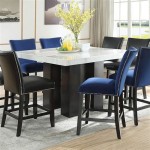Dining Room Table Rug Size Guide: Achieving Aesthetic Harmony and Functional Elegance
Selecting the appropriate rug size for a dining room table is a pivotal aspect of interior design. The rug serves not only as a decorative element but also as a functional asset, providing comfort underfoot, protecting the flooring, and defining the dining space. The correct size ensures that the rug accommodates chairs when they are pulled out from the table, preventing instability and creating a cohesive, visually appealing layout. An improperly sized rug can disrupt the flow of the room and detract from the overall aesthetic.
This guide provides a comprehensive overview of determining the ideal rug size for a dining room table, taking into consideration various factors such as table shape, room dimensions, and design preferences. By understanding these principles, individuals can make informed decisions that enhance the functionality and beauty of their dining area.
Key Point 1: The 24-Inch Rule: A Foundation for Rug Size Calculation
The cornerstone of selecting the appropriate rug size for a dining room is the "24-inch rule." This guideline stipulates that the rug should extend at least 24 inches beyond the edge of the table on all sides. This extension ensures that when chairs are pulled out for diners to sit, they remain entirely on the rug, preventing wobbling or scraping and maintaining a consistent level.
To apply the 24-inch rule, one must first measure the dimensions of the dining room table. Then, add 48 inches (24 inches on each side) to both the length and width of the table. This calculation provides the minimum recommended rug size. For example, if a rectangular dining table measures 60 inches in length and 40 inches in width, the minimum rug size should be 108 inches (60 + 48) in length and 88 inches (40 + 48) in width.
While the 24-inch rule serves as a fundamental guideline, it is essential to consider the overall dimensions of the dining room. In smaller spaces, adhering strictly to this rule may result in a rug that overwhelms the room. Conversely, in larger dining areas, a rug that is only minimally larger than the table may appear undersized and out of proportion.
In situations where the 24-inch rule would result in an awkwardly sized rug, it may be necessary to adjust the dimensions slightly. Prioritize ensuring that at least the back legs of the chairs remain on the rug when pulled out. This compromise can provide sufficient stability while maintaining a more aesthetically pleasing proportion within the room.
The shape of the table also plays a role in adapting the 24-inch rule. For round tables, measure the diameter and add 48 inches to determine the minimum rug diameter. For square tables, apply the same principle to the side length. Irregularly shaped tables require careful consideration of the widest points to ensure adequate rug coverage.
Key Point 2: Table Shape and Rug Shape: Harmonizing Forms
The relationship between the shape of the dining table and the shape of the rug significantly impacts the overall aesthetic of the dining area. While matching the shapes directly can create a sense of harmony, contrasting shapes can introduce visual interest and dynamism.
For rectangular dining tables, rectangular rugs are the most common and often safest choice. They mirror the table's shape, creating a cohesive and balanced look. However, larger rectangular rugs can also accommodate round tables, provided they are sufficiently sized to extend beyond the chairs.
Round dining tables naturally pair well with round rugs. This combination emphasizes the circular form and creates a softer, more intimate dining atmosphere. Square rugs can also work with round tables, particularly in contemporary settings, creating a contrasting geometric element.
Square dining tables are best complemented by square rugs. This mirroring effect reinforces the geometric shape and creates a sense of order. Rectangular rugs can also be used with square tables, but careful consideration must be given to the rug's proportions to ensure a balanced visual outcome.
Oval dining tables present a unique challenge. Oval rugs are often custom-made, as they are not as readily available as other shapes. Rectangular rugs can be used effectively, ensuring that the rug’s length corresponds with the table’s longest dimension. Round rugs can also work if the table is positioned centrally on the rug.
Irregularly shaped dining tables, such as those with curved or asymmetrical edges, require careful consideration. In these cases, custom-shaped rugs are often the best solution, allowing for a perfect fit that accentuates the table's unique form. Alternatively, a large rectangular or round rug can be used, ensuring that it extends sufficiently beyond the chairs on all sides, regardless of the table's exact shape.
Beyond the shape of the table, the existing architectural elements in the room, such as fireplaces, doorways, and built-in furniture, should also influence the choice of rug shape. The rug should complement these elements, creating a cohesive and visually balanced space.
Key Point 3: Room Size and Rug Placement: Creating Visual Proportions
The size of the dining room and the rug's placement within the space are crucial considerations for achieving visual harmony. A rug that is too small can make the room feel disjointed, while a rug that is too large can overwhelm the space. Precise measurements and careful placement are essential for creating a balanced and inviting dining area.
In smaller dining rooms, prioritize functionality over strict adherence to the 24-inch rule. A slightly smaller rug that accommodates the chairs when pulled out is preferable to a rug that extends too close to the walls, creating a crowded feeling. Consider leaving at least 12-18 inches of exposed flooring around the perimeter of the rug to create a visual buffer.
In larger dining rooms, a generously sized rug can help define the dining space and create a sense of intimacy. However, it is crucial to ensure that the rug remains proportional to the room's overall dimensions. If the rug is too large, it can make the room feel smaller and less airy. Aim for a rug that leaves a sufficient amount of exposed flooring around the perimeter, creating a visually appealing border.
The placement of the rug within the dining room should also be carefully considered. The rug should be centered under the dining table, ensuring that it is equidistant from the walls on all sides. This creates a sense of balance and order. If the room is not perfectly square or rectangular, adjust the rug's placement to visually center it within the most prominent area of the room.
Consider the existing furniture and architectural elements in the room when determining rug placement. Ensure that the rug does not impede doorways or obstruct walkways. If there is a buffet or sideboard in the dining room, consider the placement of the rug in relation to this furniture. Ideally, the rug should extend slightly beyond the front legs of the buffet, creating a cohesive visual connection.
The rug's pile height and texture should also be considered in relation to the room's overall style. In more formal dining rooms, a low-pile rug with a subtle pattern can create a sophisticated and elegant atmosphere. In more casual dining areas, a high-pile rug with a bolder pattern can add warmth and personality.
Finally, consider the color and pattern of the rug in relation to the existing color scheme of the dining room. The rug should complement the walls, furniture, and accessories, creating a cohesive and harmonious look. A rug with a bold pattern can serve as a focal point, while a rug with a more subtle pattern can blend seamlessly into the background.
By considering these factors, individuals can effectively select the appropriate rug size and placement for their dining room, creating a visually appealing and functionally optimized space. The right rug not only enhances the aesthetic appeal of the room but also provides comfort, protection, and a sense of cohesion.

A Simple Guide To Choosing The Right Rug Size For Dining Room

How To Pick Rug Sizes Design Guide Dining Room Size Living Table

How To Choose The Right Rug Size

Standard Rug Sizes The Right Sized For Every Room Jessica Welling Interiors

Expert Advice How To Design A Perfectly Scaled Dining Room Rug Size Layout Carpet

Everything You Need To Know About Dining Rooms Your Guide Getting The Scale Just Right Kayla Simone Home

What Size Rug To Use In A Dining Room Green With Decor

Rug Size Guide Ballard Designs

Rug Size Guide Choose The Right

Sparkling Typical Rug Sizes Graphics Luxury Or Dining Room Rugs Size Area Table








